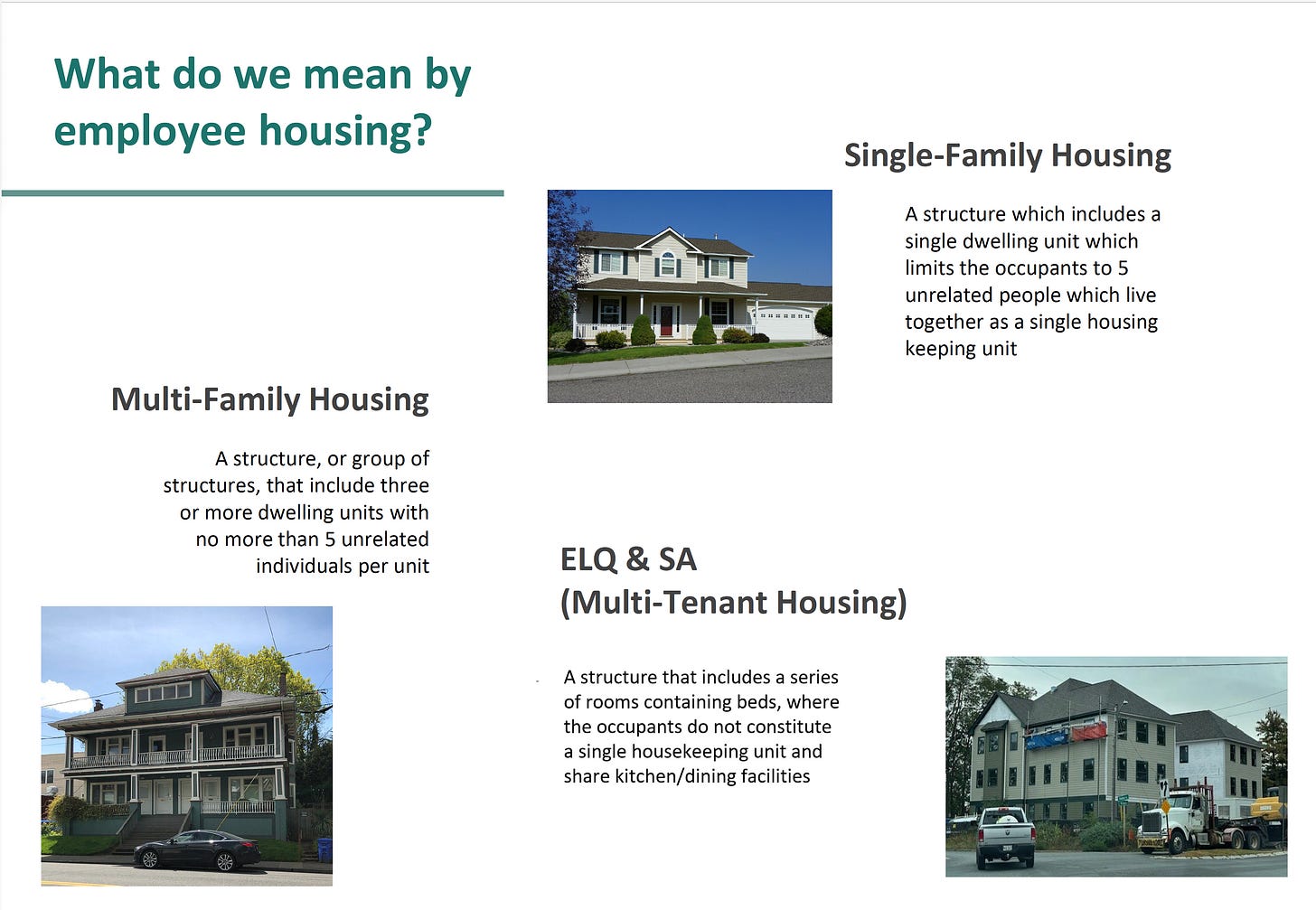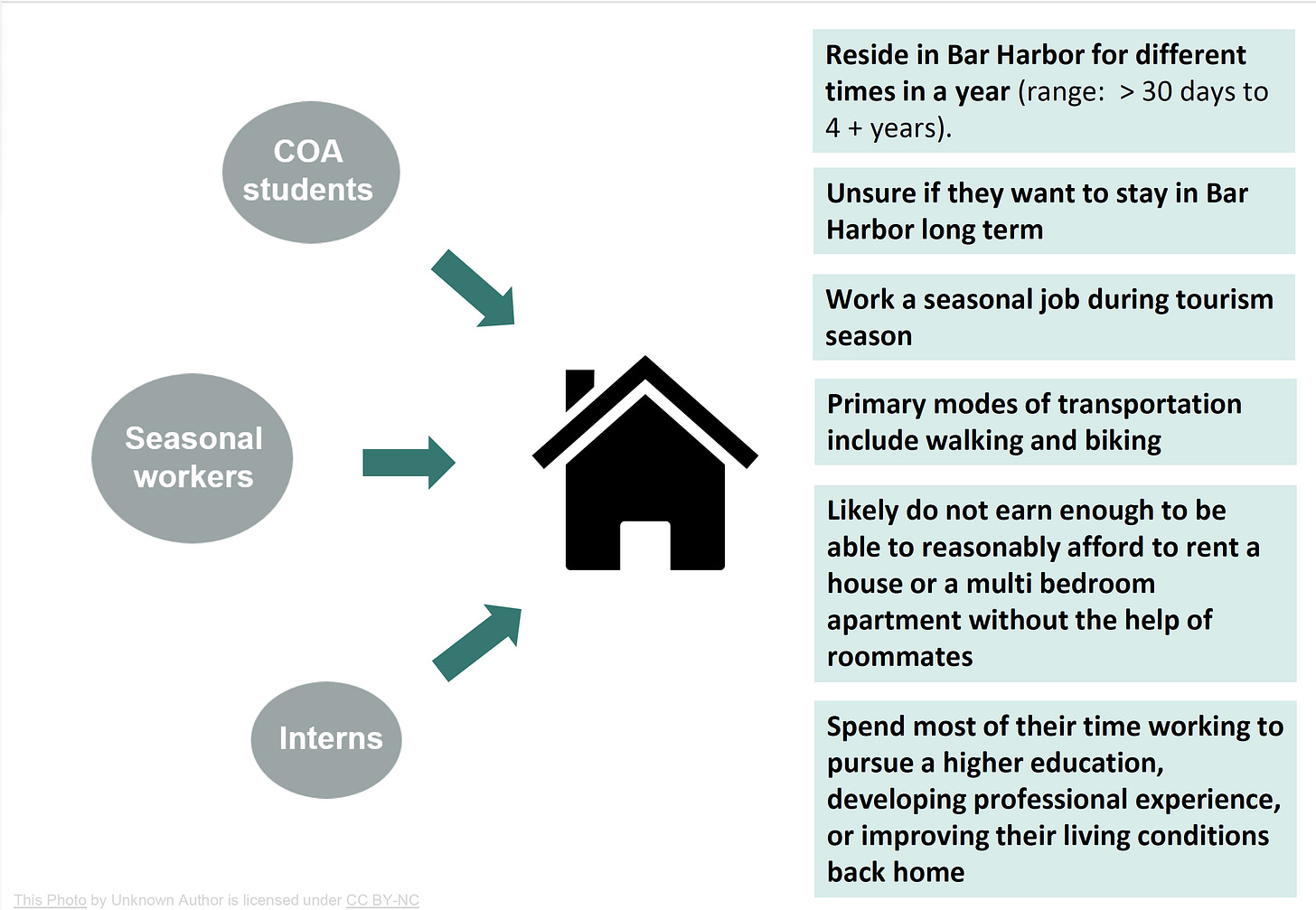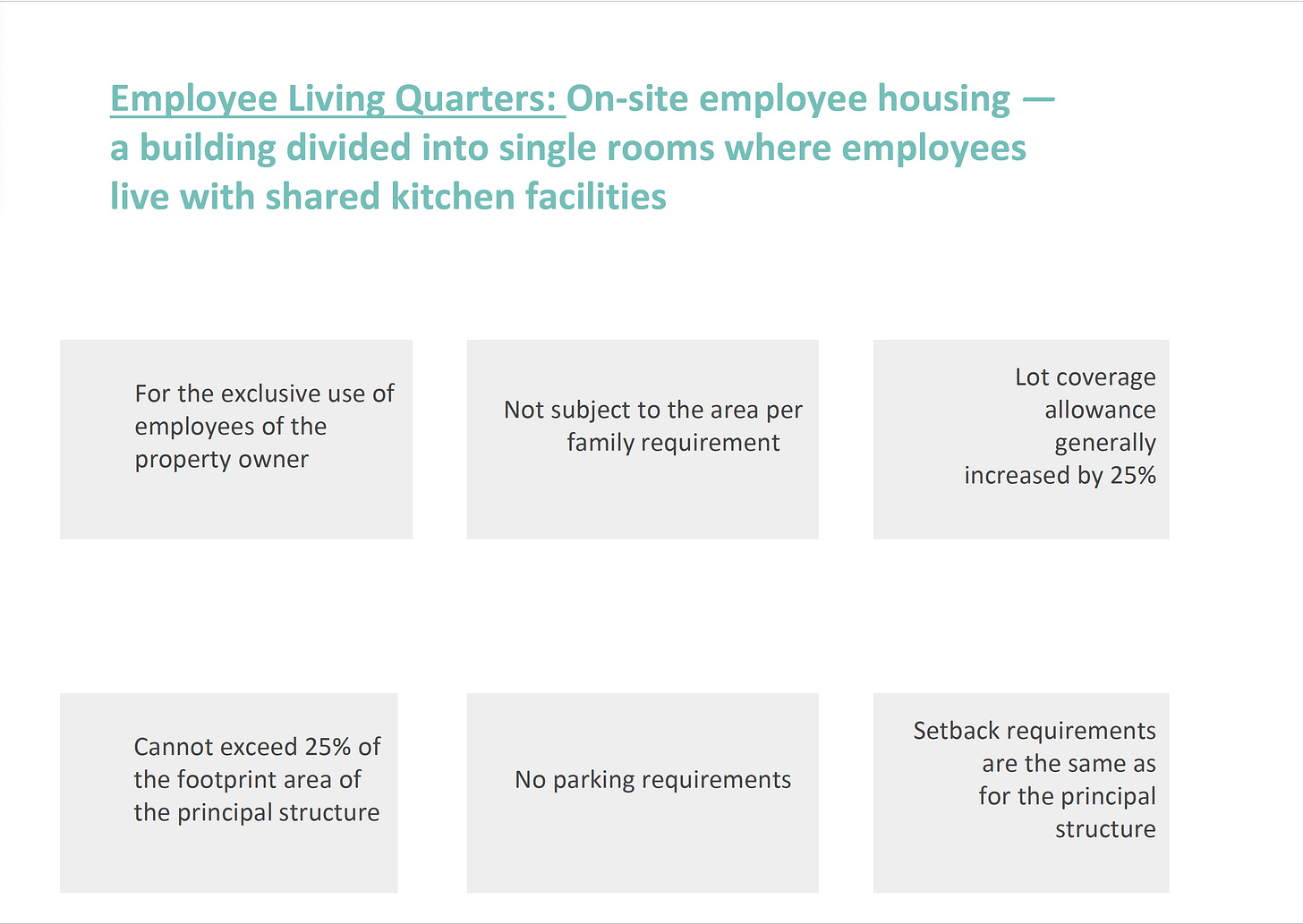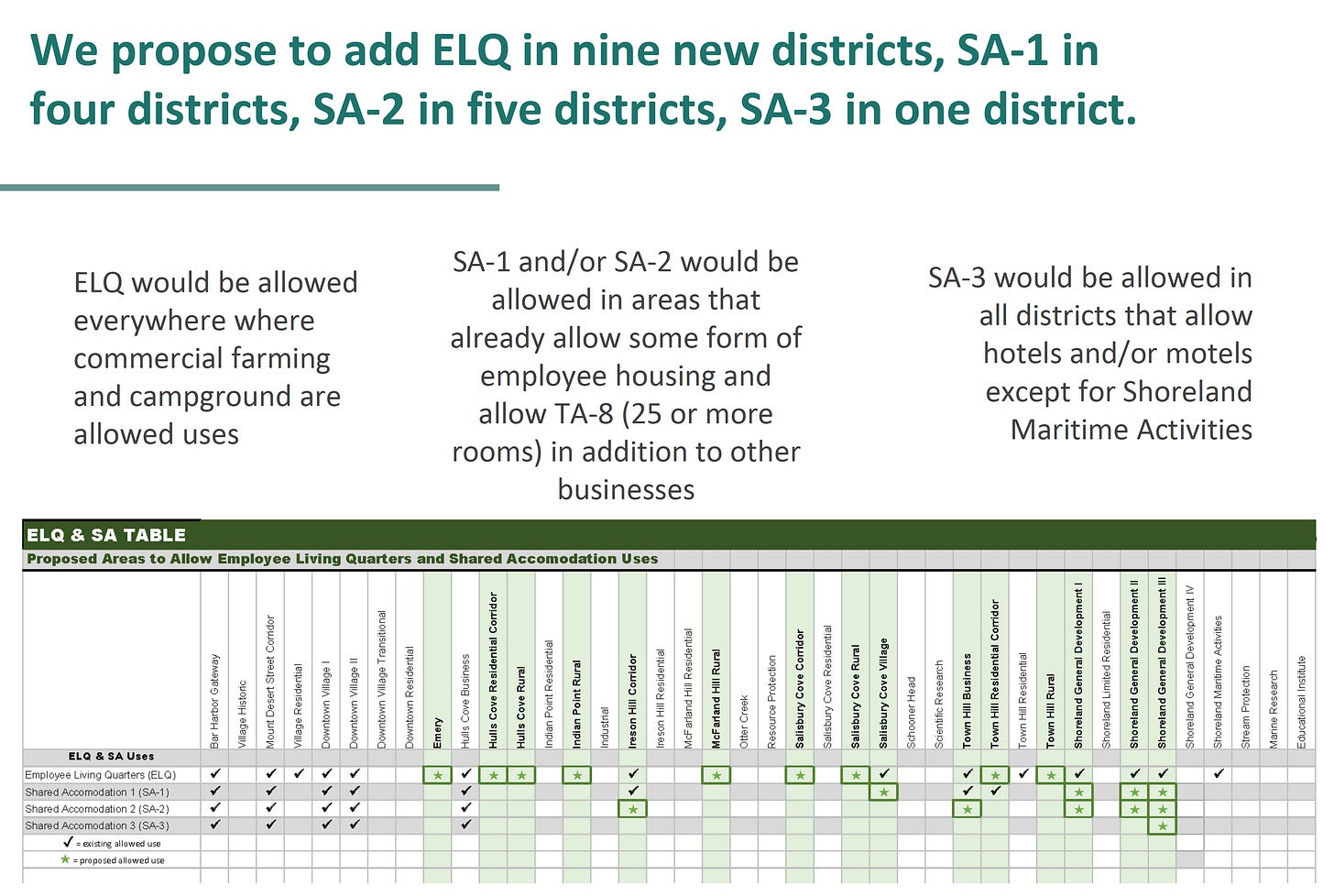Bar Harbor's Planning Department Works To Make Potential Changes. Will the Town Be Ready To, Too?
Martinez discusses possible expansion of where employee living quarters and shared accommodations are allowed to be built
BAR HARBOR—Bar Harbor planners presented another step that they hope, if voters approve, will help ease the town’s housing crisis.
On Thursday, October 26, during a listening session, staff detailed a proposed changes to the town’s land use ordinance that would create more areas for employee living quarters (ELQ) and shared accommodations (SA), types of specific housing that is geared toward more transient employees, students, and interns.
The changes are meant to be a part of the bigger picture of town efforts to help alleviate the housing crisis.
“Bar Harbor is in a housing crisis as are many areas in the U.S.,” said Bar Harbor’s Housing and Community Planner Cali Martinez said at the beginning of the listening session, which was held in Council Chambers on the third floor of the Bar Harbor Municipal Building on Cottage Street. The suggestions are all proposed, currently in draft form, and would need to be approved via ballot by voters.
There are four general types of housing allowed in Bar Harbor. Single family homes and multi-family homes are easily understandable. They are buildings that house one family group or multiple family groups.
The types of housing that would be expanded are shared accommodations and employee living quarters, two new types that were proposed and adopted by voters in 2020.
Martinez, Code Enforcement Officer Angela Chamberlain, and Planning Director Michele Gagnon were at the session, which Martinez led. A handful of the public was in attendance. It could also be viewed via Town Hall Streams and that link is below.
Last week, Chamberlain also held a listening session about potential changes to the definitions of transient accommodations in towns (there are currently many types) and where they would be allowed.
THE GOAL AND THE RATIONALE
The amendment would hope to increase opportunities to COA students, seasonal workers, and interns and address the issue of housing affordability. One of the factors that can contribute to increased housing costs and lack of availability when there is little developable land and high costs of labor and materials is seasonal businesses converting year-round dwellings into seasonal employee housing, Martinez said. She stressed that she and the town were not trying to villainize those businesses, which are buying and converting year-round dwellings to house seasonal employees.
Two other deterrents to building more seasonal housing is within the town’s land use ordinance. This is the area-per-family-dimensional standard and the rule that allows a maximum of five unrelated people in a dwelling unit. Both limit the amount of occupants that can be housed by institutions and employers, she said.
She explained the area-per-family-dimensional standard both verbally and through a chalk drawing on the back board of the Council Chambers.
If a developer has a 40,000-square foot lot and there is a 20,000-square foot area per family dwelling standard for that lot, there could only be two dwellings on the lot and a maximum of 10 people. Without the area-per-family-dimensional standard, it could be 20 people or more on that same lot.
WHO THE ORDINANCE IS GEARED TO HELP
The ordinance is specifically focused on creating housing for people who are in Bar Harbor for than 30 days or more than four years. These people, Martinez said, would also be more likely to look for rental housing rather than year round housing and many in the group do not have cars or earn enough to afford renting a house or apartment without roommates.
By expanding the uses to other districts, the town would hope to expand opportunities for employees to build this type of living quarters and for employers and others to build shared accommodations.
Atlantic Oceanside has employee living quarters, which is on site. It is a building divided into single rooms where the employees share kitchen facilities. There are no parking requirements.
Shared Accommodations are at the Project Social, the hospital’s under-construction housing center that will accommodate eight medical professionals and students, and the Witham Family building at the corner of Kebo Street.
There are three different types of shared accommodations as defined by the town. These do not have to be attached to commercial use the way that employee living quarters do. There is no area per family requirement, and parking requirements are minimum. It needs Planning Board approval.
ELQ are currently allowed in 14 of Bar Harbor’s 40 zoning districts. Shared accommodations are currently allowed in eight.
THE PROPOSED CHANGES
The amendment proposes additional locations to allow both shared accommodations and employee living quarters. It would add ELQ to nine new districts, SA-1 in four districts, SA-2 in five, and SA-3 in one.
The employee living quarters would be allowed everywhere where commercial farming and campgrounds are allowed uses. SA-1 and SA-2 would be allowed where there is already some form of employee housing and where it allows TA-8 (25 or more rooms) in addition to other businesses. SA-3 would be allowed in the same districts that allow hotels and motels, except for the Shoreland Maritime Activity district.
The amendment would allow the use in Shoreland General Development 1 because it is in downtown Bar Harbor, which is served by town water and sewer as well as a designated growth area in the past Comprehensive Plan and the upcoming draft Comprehensive Plan. It is also proposed for the Shoreland General Development Districts 3 and 2.
PAST CONCERNS ABOUT THE PROPOSAL
Concerns have included adding demands on water reserves in the the rural districts. Adequate water capacity would be reviewed both by the town’s fire chief and the public works staff, Martinez said.
Others have questioned the power dynamic of employer-provided housing. If an employee’s home is controlled by their employer, the questions becomes what happens if the employee changes jobs. Does the employee lose that living space? Even if they do stay with their employer, people have wondered if they are now overly beholden to their employer, and does that create a system of oppression and inequity.
Another concern brought up to the planning department is how to keep these dwellings from becoming life or safety hazards. There is an annual inspection for these dwellings, Martinez said. The Town Council would also hear public comments and if there had been any police complaints during that annual license renewal process.
THE HOPE
The hope is that by building these units, such as the Witham property at Kebo Street that is currently under construction, it could potentially open up other types of housing by putting single family homes currently housing seasonal employees back on the market. Employers could move workers housed in converted single family homes into those larger employee living quarters or shared living accommodations.
The hope is that some of the houses in Bar Harbor used for seasonal employees, students, or interns would be single family, year-round homes again.
Sharon Linscott works at the MDI Bio Lab, which is looking at its five-year-growth plan. She asked Thursday about potentially allowing ELQs in the lab’s primary district, which is not one included in the current proposal.
THURSDAY’S CONCERNS AND DISCUSSION
Stewart Brecher said that getting into social engineering is a risky business.
“I don’t understand how the town has the resources” to continue to monitor shared housing, he said.
The hospital’s current building, he said, does not have kitchens. He thinks that there is a lot more that needs to go into the details of the plan to prevent slum housing, which he said he saw when he lived in New York. He said he thinks it’s important for the college and the labs, but he isn’t sure if the town’s existing infrastructure would support the development in the proposed areas.
Gagnon said that when the town initially created ELQs and SAs, it was very concerned about monitoring the uses. They heard concerns similar to Brecher’s back then.
This, she said, is why the licensing for those two uses have to occur every year. The reason for that “is to ensure that on a yearly basis there is the ability for how the use has been conducted to be reviewed,” she said.
She also said the licensing provisions for the uses were developed in close concert with making sure the town was meeting building code and provisions met life safety standards.
Sarah Mangs suggested that the town make sure that the dwelling occupants are provided clean filtered water. She said her own well has arsenic in it.
Rural areas, she said, are not bikeable or walkable, and she believes they do need to require parking spaces in rural areas. She said she came from northern Virginia where cars clog roads two miles away from metro stops. Rural areas cannot be relied on for internet connectivity and that people expect that in today’s environment. She also said that digging a well in a neighborhood can impact other neighbors and this is a real concern for a lot of residents in rural areas.
Glenon Friedmann, one of the owners of Bar Harbor Farm, said that if anyone was excited about the amendment, she said, it would be her. The farm employees 4-9 people each season.
“It’s a struggle to find housing for, right now, four full-time people,” she said.
The kinds of hours and split shifts in the agricultural business really lends itself to a community atmosphere with the employees, she said, all of whom would love to be on the farm.
“This amendment would really help us out a lot,” she said.
At a February 3 Planning Board meeting, Friedmann said that one of the farm’s biggest challenges is employee housing. Friedmann asked that farm employee housing be added as an allowed use in the zone.
Gagnon had said that the planning staff has been talking about expanding the district where that was allowed. Or a similar use could potentially be added to the Town Hill Rural district.
“Employee housing is needed for more than restaurants and downtown shops,” she’d said.
On Thursday, one resident asked about traffic and concerns of putting more housing and potentially more personal vehicles on already congested island roads. Gagnon said the Town Council has started a conversation about housing and traffic congestion and tourism management.
Pat North Hughes said that in some areas there is an option to build a well or hook into the town water and she requested that where that option exists, the town ask the dwellings to hook into the town’s water system.
Stephen Coston commended the presentation and said the town might want to consider merging downtown village 1 and 2, and also consider height bonuses in certain areas to incentivize.
He provides employee housing for 40 people and knows that Acadia Corporation, Cool as a Moose, Debbahs, Michael Boland and Deirdre Swords, Project Social, and several hoteliers house employees. He said he gives that housing away and doesn’t collect rent on it. He doesn’t, he said, want to be in the housing business. “It’s just an added headache,” he said, but he does it because he feels like it’s needed and the right thing to do.
“I think there are a lot of people who run small businesses who would be interested in these uses,” Coston said. “I think there is a lot of interest in the community.”
He thinks that everyone at the meeting owns a single family home. The people who the amendment it is meant to help are not there to speak to it, he said.
“You don’t hear from them,” he said.
“No business in their right mind wouldn’t raise wages to be open more” if they could get labor to do so, Coston said. He said it’s a housing supply issue. There is little housing available for workers.
“It’s really a supply issue in many ways,” Coston said. Even if wages were raised, there is nowhere available for people to rent, he said. He felt that the planning department was on the right track. “I feel like it’s important to keep in mind that the people who need this and would benefit from it aren’t here to share their opinion.”
TIMELINE
Martinez presented a timeline for the changes to be on the June 2024 ballot.
RECENT LINKS TO LEARN MORE
Unless otherwise noted, all images via Martinez presentations.
A LOT OF LINKS TO LEARN MORE
You can also search “housing” of “employee living quarters” under the search bar to see earlier stories. We have a lot more stories about this.




















